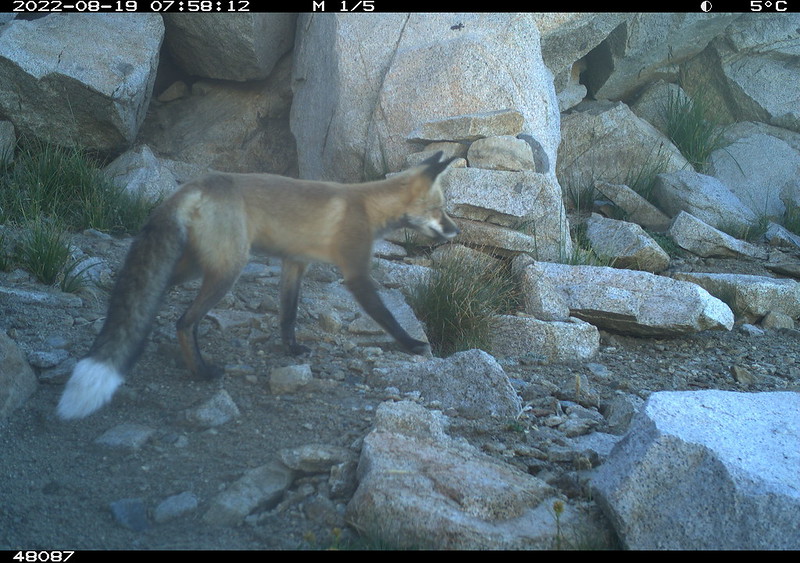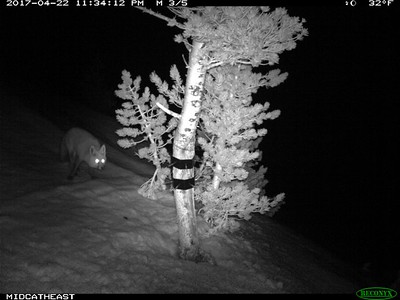Rare Sierra Nevada Red Fox Conservation Study Offers Hope For Species
The following is courtesy of Oregon State University:

Oregon State study provides foundation for protecting rare fox in Cascades, Sierra Nevada
CORVALLIS, Ore. – Conservation efforts for the rare Sierra Nevada red fox can be strengthened through new computer modeling based on a 12-year data gathering partnership led by scientists at Oregon State University’s Institute for Natural Resources, says a researcher who helped direct the project.
The endangered fox lives at high elevation in California’s Sierra Nevada and Oregon’s Cascade Range. Its numbers have been falling for two centuries largely because of human activity including trapping and poisoning, and a warming climate may be making the problem worse, OSU wildlife ecologist Sean Matthews said.
“Low genetic diversity from inbreeding, hybridization with non-native red foxes, and influences of climate change threaten the persistence of the subspecies across its range,” said Matthews, who co-led the study published in the Journal of Mammalogy. “Our results provide a demonstration for studying elusive species with limited survey data, a guide for future survey efforts and a baseline to inform conservation and management action.”
The endangered fox lives at high elevation in California’s Sierra Nevada and Oregon’s Cascade Range. Its numbers have been falling for two centuries largely because of human activity including trapping and poisoning, and a warming climate may be making the problem worse, OSU wildlife ecologist Sean Matthews said.
Researchers including scientists at the California Department of Fish and Wildlife, the University of California, Davis, and Yosemite National Park modeled the potential distribution and abundance of the Sierra Nevada red fox throughout its historical and contemporary ranges.
Sierra Nevada red foxes, known scientifically as Vulpes vulpes necator, live in a mix of habitats above and below timberline, Matthews said, including meadows, mature forests, talus slopes and fell fields – rock-strewn open areas higher than the tree line.
“The Sierra Nevada red fox experienced large population declines over the last 100 years,” he said. “There are historical records of red foxes around Mount Shasta and in the Klamath Mountains, areas now devoid of red foxes. Our limited understanding of the fox’s ecology has hindered the development of informed conservation actions.”

The study team, which also included scientists at the U.S. Forest Service, California Polytechnic State University, San Luis Obispo, and the Cascades Carnivore Project, was able to estimate the distribution and population sizes of Sierra Nevada red foxes by using data collected via remotely triggered cameras and other survey tools.
The survey period was 2009 through 2020. The modeling approach predicted fox density based on the relationship between detection frequencies and environmental characteristics, allowing for the model to project those densities onto unsampled areas with similar land and vegetation features.
“That’s important because it’s not really possible to sample every individual remote area the Sierra Nevada red fox might be living,” Matthews said.
Generally, he said, foxes were detected in areas with high amounts of snow and low minimum temperatures; the Sierra Nevada red fox has several adaptations for living in snowy areas, including a thick winter coat and small toe pads covered in dense fur. Foxes were most likely to be detected by a camera in open areas and on gentle slopes.
“We identified areas occupied by Sierra Nevada red fox at very low densities – just over one fox per 100 square kilometers – in the Oregon Cascades, the central Sierra Nevada and around Lassen Peak,” Matthews said. “They naturally occur at low densities, but now that they occupy smaller portions of their historical range, there are very few foxes in these areas, which can lead to negative genetic consequences.”
A conservation objective, he said, would be increasing connectivity between fox population areas. That could come in the form of land use decisions that limit habitat fragmentation when projects like highway expansion, recreational development and housing subdivisions are planned.
Other actions that could benefit the Sierra Nevada red fox include lowering vehicle speed limits, building wildlife crossing infrastructure and reintroducing foxes in some areas to increase populations and genetic diversity, Matthews said.
David Green, formerly of OSU’s Institute for Natural Resources, also co-led the study, which was funded by the U.S. Fish and Wildlife Service, the Yosemite Conservancy and Yosemite National Park.

About Oregon State University: As one of only three land, sea, space and sun grant universities in the nation, Oregon State serves Oregon and the world by working on today’s most pressing issues. Our more than 35,000 students come from across the globe, and our programs operate in every Oregon county. Oregon State receives more research funding than all of the state’s comprehensive public universities combined. At our campuses in Corvallis and Bend, marine research center in Newport, OSU Portland Center and award-winning Ecampus, we excel at shaping today’s students into tomorrow’s leaders.
On-campus TV and radio services: Oregon State University is equipped with on-campus television and radio studios/services that can be used by journalists. Live or live-to-tape broadcast television and radio interviews can be conducted using Vyvx, Zoom, Webex or Comrex (IP Audio). Oregon State staff can also gather b-roll and coordinate live-to-tape interviews on locations throughout campus. For radio, Oregon State’s Comrex (IP Audio) provides a broadcast-quality audio feed.



